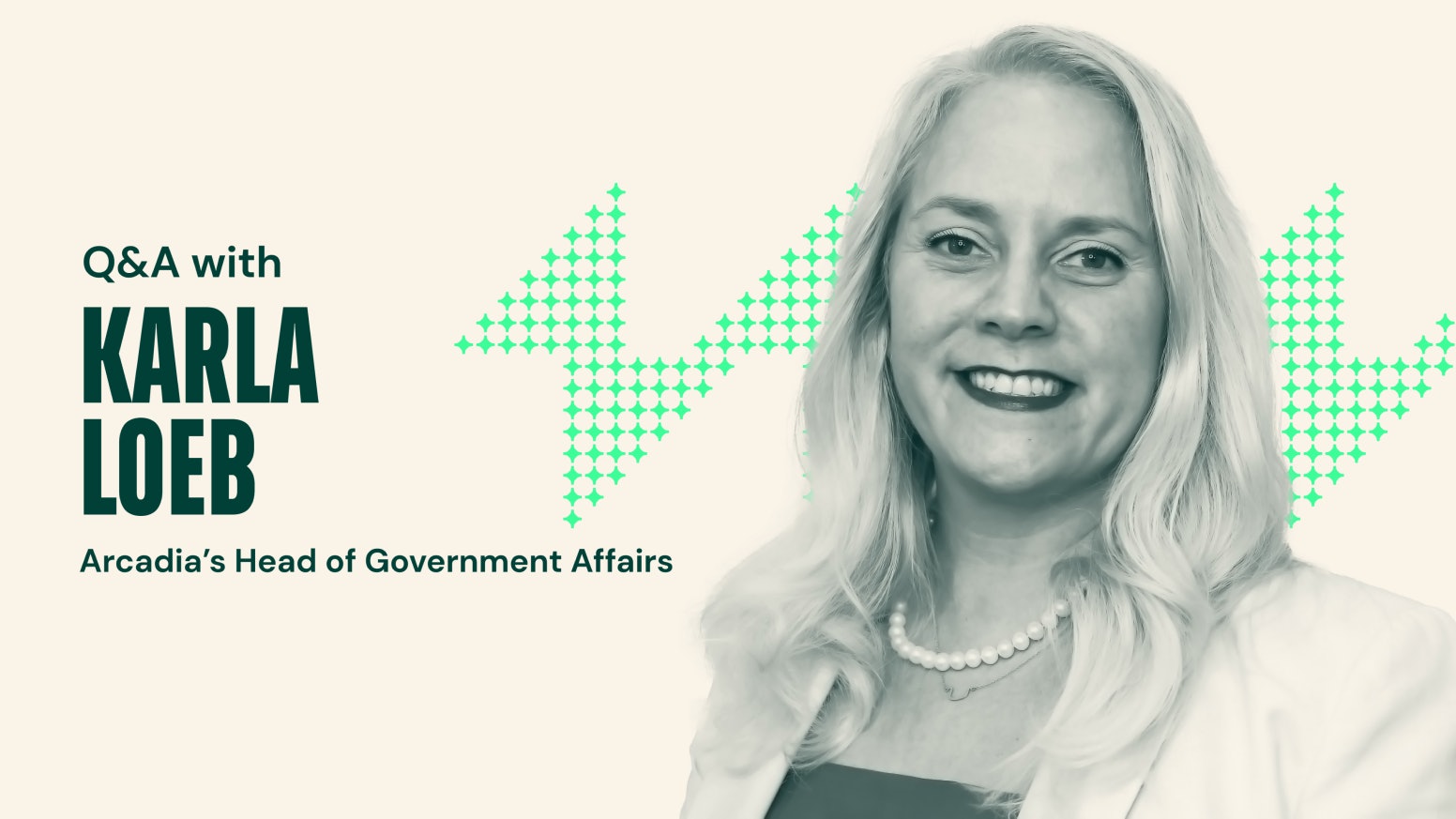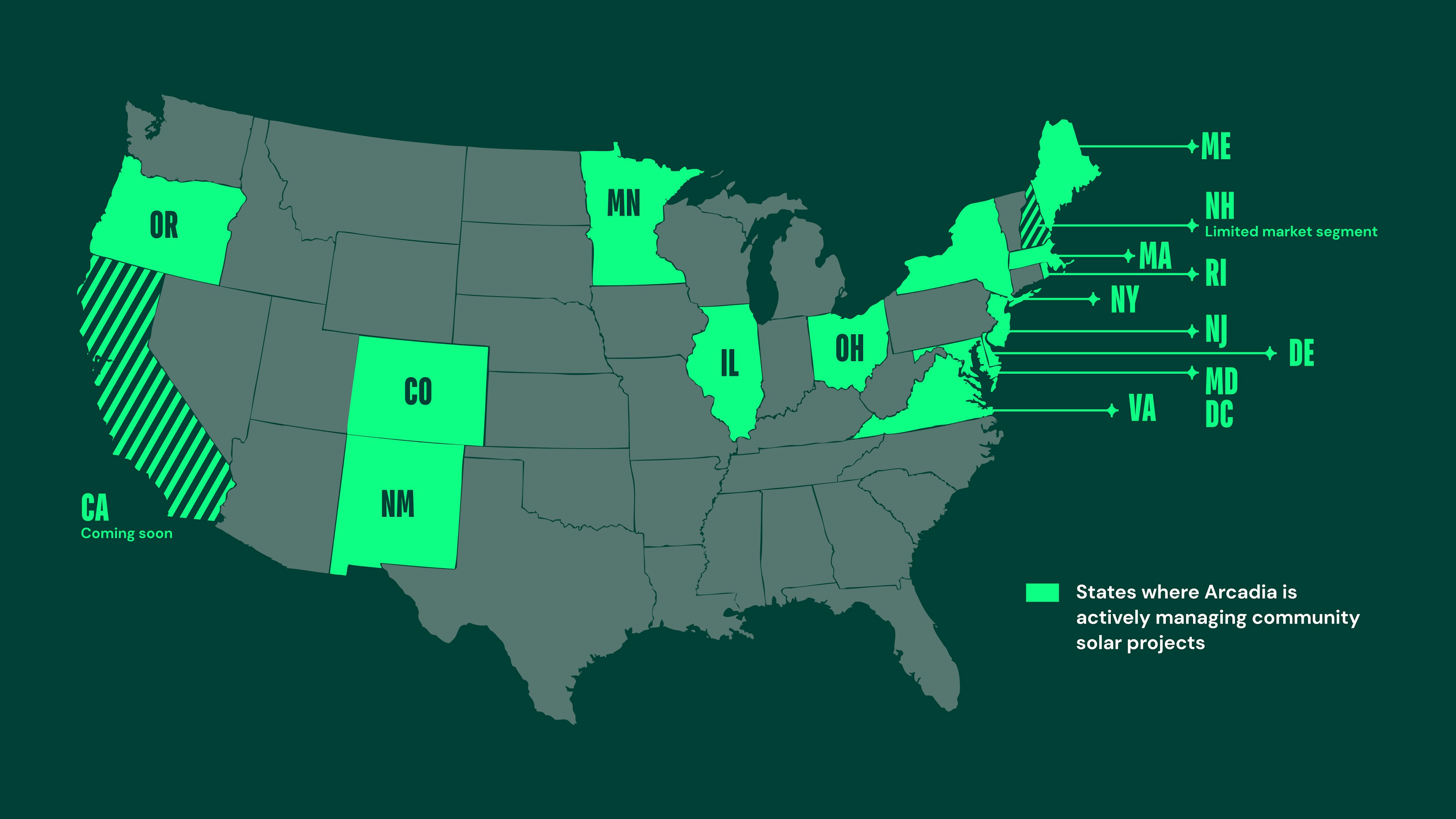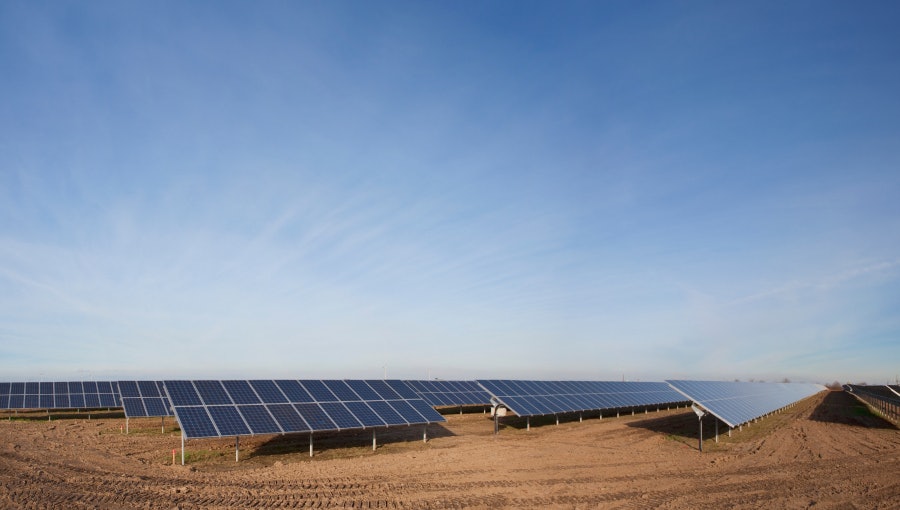Q&A with Karla Loeb, Arcadia’s new Head of Government Affairs

At Arcadia, we’re constantly working towards the vision of a 100% zero-carbon future. Helping Arcadia usher in this clean energy transition is Karla Loeb, our new Head of Government Affairs.
With over 15 years of experience in the clean energy industry, Karla brings a wealth of knowledge to the Arcadia policy team as Head of Government Affairs. In addition to her role at Arcadia, Karla serves as the elected representative of the distributed generation division on the Solar Energy Industries Association Board of Directors and on the Executive Committee. She acts as the State Policy chair, as well as the policy chair for the DEIJ Committee. Karla’s first term on the board began in 2017. Karla has established and informed clean energy policies in over a dozen states, including those dealing with energy equity. She has been featured on the Suncast Podcast for her work on the Virginia Clean Economy Act and diversity, equity, and inclusion, and is a regular speaker at the leading energy conferences across the US. She is well known in the climate advocacy arena, as well as environmental justice circles, often acting as a liaison between industry and non-profit advocates. Most recently, she worked to bring industry leaders and advocates together to support environmental justice and distributed provisions in the Inflation Reduction Act (IRA).
Karla has already begun diving into her work as Head of Government Affairs. From Monday, Sept. 19 to Thursday, Sept. 22, she will be at RE+, where she will attend the first SEIA board meeting since the IRA passage. She will also speak on a community solar panel, providing further insight on the opportunities for community solar growth in new and existing state markets. Karla has been working with a variety of stakeholders on conference agendas across the country to ensure the industry has the resources to make informed decisions as to how their businesses will be impacted by the passage of the IRA, particularly as it relates to community solar.
While Karla was brought on board to lead government affairs, generally, the groundbreaking passage of the IRA has dramatically changed her focus and created even more opportunities for Arcadia’s business verticals. We sat down and talked with Karla about how this monumental law will impact the community solar industry, as well as other clean energy technologies.
Our conversation has been edited for clarity and length.
Arcadia: As the new Head of Government Affairs, what work will you focus on at Arcadia?
Karla Loeb: As an industry veteran with a leadership role on the trade association board of directors and executive committee, I have a broad and comprehensive understanding of the solar and clean technology industries. Our country just passed transformational energy legislation that is going to propel solar and electrification to center stage. While most community solar policy is developed at the state level, the financial juice provided by the IRA will enable more projects to pencil and unleash more cash in the capital markets to support solar and clean technology deployment. It is the one-two punch the industry has been waiting on for decades.
The community solar battles will continue to be fought in the states, but with added financial support from the federal government and greater capital market interest, I believe the winds will be at our backs for the first time in my career. That being said, barriers to community solar deployment still exist in more than half of the states around the country. But that is where the IRA comes in. Billions of dollars have been allocated and earmarked to help support solar deployment in environmental justice communities, energy communities, and disadvantaged communities. This will catapult community solar deployment and highlight the benefits of the least intrusive, most economic and accessible form of solar energy.
My focus in the next 12 to 18 months will be to make sure the lessons I have learned from state solar and clean energy fights will be applied to implementation strategies of the tax and grant provisions included in the IRA. I will protect the federal wins and continue to implement comprehensive strategies to open up and expand state community solar markets, as well as facilitate the deployment of household clean technology solutions, including electric vehicles, high-efficiency appliances, and home energy management solutions. This will be achieved through strategic coalition building, education, and effective communication with key allies, stakeholders, and elected officials. We need to end — once and for all — false narratives about clean energy and highlight the exponential economic, job, security, and environmental benefits community solar brings to our communities.
Let’s chat more about the IRA. Could you give us a brief description of this legislation?
The IRA is a transformational piece of legislation focusing on clean energy, climate, manufacturing, and environmental justice provisions alongside prescription drug reform. About $369 billion is centered on the energy-related provisions. The landmark policies captured in the legislation are meant to change how we consume, save, and spend money on energy while ensuring all members of our society have a pathway to participation and benefit. In fact, the IRA will allow America to reduce carbon emissions by 40% through cleaner, cheaper, and more reliable resources. This is the single most transformational piece of climate legislation in US history. It positions the United States to be the global leader on climate and energy solutions.
We’ve been hearing a lot of buzz about how the IRA impacts the Investment Tax Credit (ITC). What exactly is the ITC, and how does it impact community solar?
In 2006, Congress established a new way to incentivize companies to build solar energy projects: The Investment Tax Credit (ITC). (Previously, the ITC had been limited to wind energy projects.) The ITC provides a 30% tax credit for solar installations built for homes and businesses. The credit reduces tax liabilities for individuals and businesses.
Since the solar ITC initially started, America’s solar industry has grown by 10,000%. Companies have substantially benefited from applying the tax credit to their panels, labor, technology, and other expenses. But the ITC was set to phase out in 2024, which would virtually suspend the development of solar projects and the country’s clean energy and carbon reduction goals.
That all changed last month. Congress took action and passed the IRA, which includes a critical 10-year extension of the ITC. Not only is the ITC extended through 2032, but the ITC now has the potential to be over 50% with available adders (for projects 5MW or smaller), when contingent eligibility requirements are met. For a traditional 5MW community solar project, a baseline 6% plus an additional 24% applies if projects fulfill prevailing wage and apprenticeship requirements; that equates to a 30% tax credit. Adders include domestic content, energy community, and allocated low-income community credits. This suite of ITC bonus credits position community solar to be one of the fastest growing sectors in the energy industry.
How does the IRA specifically affect community solar projects and the work that Arcadia is doing?
Arcadia enables energy consumers to source clean energy from community-based solar projects made possible by Arcadia’s solar developer partnerships. The IRA is significantly impacting the economics of solar developers’ projects in three different ways, which will allow them to build more projects for homes and businesses than ever before:
- The first way is through the ITC credits which, as I mentioned, previously can be stacked. (The Department of Treasury will issue guidance on the various ITC credits and adders in the coming months. Until this happens, it is unclear if there will be limitations on a maximum that can be claimed in credits.) Under the ITC, every $100,000 spent on building a solar project grants a credit of $30,000, or 30% provided the prevailing wage and apprenticeship requirements are met for federal tax liabilities. However, if 50% of the project’s capacity can show that it’s benefiting low-income individuals, the tax credit can increase from 30% to 50%. This increase will further incentivize solar developers to build projects serving low-income households, enabling Arcadia to expand its reach of providing community solar to everyone, regardless of socioeconomic status.
- Another provision providing substantial benefits to the community solar industry is the inclusion of interconnection costs into project costs for sub-5MW projects. One of the most frustrating aspects for solar developers is the inflated costs to interconnect projects to the electric grid. The pre-IRA ITC did not include the ability to include interconnection costs into a project’s ITC calculation. As a result, oftentimes interconnection costs were so preclusively expensive that the economics of the projects could not pencil. But now, more projects that are less than 5MW in capacity — enough to power several hundred homes — will pencil. Starting Jan. 1, 2023, solar developers will finally find relief from high interconnection costs, allowing for more projects to be built and ultimately furthering Arcadia’s mission of ushering in a zero-carbon world.
- Lastly, the IRA will provide $7 billion to fund state, local, and nonprofit programs to install zero-emission distributed energy technologies, including community solar, in low-income and disadvantaged communities (including tribal governments). This provision will enable the community solar industry, alongside Arcadia, to develop and implement policies that ensure a just, inclusive, and equitable energy transition.
Looking to the future, how do you envision the IRA impacting the solar and clean energy industries as a whole?
The IRA is setting up our country to experience what some folks are calling the “solar rush” — an energy resource transformation from traditional energy to solar and clean energy technologies. This will take place on a national scale and focus on resources that never run out: solar and innovative technologies and solutions. Millions of jobs will be created and solar and clean technologies will be deployed at scale resulting in lower-cost clean energy. Low- and middle-income communities throughout the country will have more access to clean energy at affordable prices through targeted policies and incentives. Every American will benefit, regardless of socioeconomic status, location, race, gender, or political alignment.
How will this single piece of legislation have such widespread impacts?
The IRA and the policies contained within it are meant to overhaul and recalibrate how Americans get their energy. It does this by incentivizing usage of products that leverage electric energy and focusing deployment of these technologies in non-traditional sites and sectors, like former energy communities, the transportation sector, and domestic manufacturing. Key provisions in the IRA that illustrate this include:
- Energy Community Bonus ITC (up to 10%) for projects developed on brownfield sites, in areas where coal mines closed after 1999, or a coal power plant was retired after 2009, or an energy community financially dependent on the fossil fuel industry (economically or job-dependent).
- Allocated low-income ITC adder mentioned above (the choice of either 10% for siting or 20% benefiting households).
- Greenhouse Gas Reduction Fund, including $7 billion to install zero-emission distributed technologies in low-income and disadvantaged communities.
- $3 billion in Environmental and Climate Justice Block Grants.
- $11.6 billion in funding to USDA to support deployment of renewable energy.
- Electric vehicle tax credits, commercial vehicle tax credits, and used electric vehicle tax credits.
- Residential Efficiency and Electrification Rebates and High-Efficiency Electric Home Rebate Program.
- Domestic Content Bonus ITC (up to 2%) for steel and other domestically mined or produced productions.
- Advanced Manufacturing PTC for solar panel components, inverters, trackers, and batteries.
Every part of the US energy economy will be impacted by this legislation, providing jobs; insulating our country from a global energy crisis and volatile fossil fuel prices; and ensuring every American — from our Native American communities to our traditional energy employees and our New York City residents — will benefit from the New Energy Economy.


